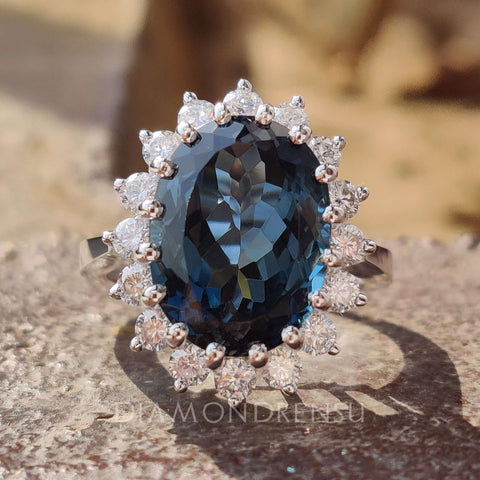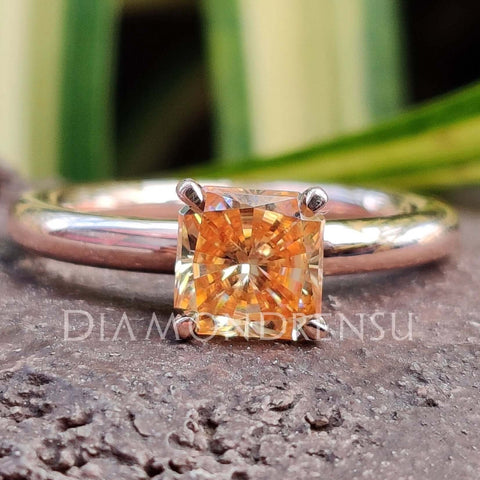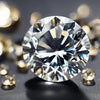
Does Moissanite Glow Under a Blacklight?
Moissanite, a popular and affordable alternative to diamonds, has gained a lot of attention in recent years due to its impressive durability, sparkle, and ethical production. As a lab-created gemstone, it shares many properties with diamonds, which can create confusion when attempting to differentiate between the two. A common question that arises concerning moissanite is whether it glows under a blacklight, also known as ultraviolet (UV) light.

Blacklights emit UV light, which can cause some materials to fluoresce, experiencing a brief and visible glow. This unique reaction serves as a helpful tool in detecting certain gemstones and evaluating their authenticity. When it comes to moissanite, its response to UV light can vary, depending on factors such as the gemstone's quality and the type of blacklight used.
Although some moissanite gemstones may exhibit a faint glow under a blacklight, this property is not consistent across all stones and should not be solely relied upon for identification purposes. Testing methods such as examining the gemstone's refractive index and specific gravity are more accurate in differentiating moissanite from other gemstones, including diamonds.
Table Of Contents
Exploring the Nature of Moissanite
Moissanite is a gemstone made from silicon carbide, and it has become increasingly popular due to its appealing properties and affordability. Synthetic moissanite, in particular, is often used as an alternative to diamonds in various jewelry designs, such as moissanite rings. The unique qualities of moissanite can be attributed to its composition and crystal structure.
One of the most notable properties of moissanite is its high refractive index, which results in its incredible sparkle and brilliance. This gemstone's refractive index is higher than that of a diamond, making it an eye-catching choice for jewelry enthusiasts. The double refraction of light within the moissanite crystal also contributes to its remarkable appearance, setting it apart from other gemstones.
In terms of hardness, moissanite scores 9.25 on the Mohs scale, making it one of the hardest gemstones known to humankind. This level of hardness adds to its durability and longevity, ensuring that it retains its beauty even after years of wear. Furthermore, moissanite is much more affordable than other gemstones with similar qualities, so it has become an increasingly popular choice for those searching for loose moissanite stones for various applications.
With its striking beauty, durability, and affordability, moissanite is a sought-after gemstone for various jewelry pieces. Its unique properties and synthetic nature make it a practical and appealing alternative to traditional gemstones, such as diamonds. As interest in this material continues to grow, it is critical to understand the qualities that make moissanite an appealing choice for jewelry enthusiasts and knowledgeable collectors alike.
Influence of UV Light on Moissanite

Moissanite, a popular diamond alternative, is known for its impressive sparkle and durability. When exposed to ultraviolet (UV) light, such as that emitted by a black light, moissanite may exhibit some interesting visual effects.
UV light is a form of electromagnetic radiation that falls just outside the visible light spectrum. Black lights, specifically, emit longwave ultraviolet radiation, which is commonly used to make certain objects and materials glow in dark settings. This glowing effect, known as fluorescence, occurs when UV light is absorbed by a substance and then re-emitted as visible light at a different wavelength.
In the case of moissanite, exposure to UV light can result in a noticeable change in its appearance. According to a book on the many meanings of diamonds, it's mentioned that moissanite may fluoresce when placed in a UV-lit environment, similar to how about a third of diamonds exhibit fluorescence under ultraviolet light.
The color of fluorescence in moissanite can vary, but it often falls within the blue or green spectrum. Although the intensity of fluorescence is also variable, the glow may be more pronounced under shortwave UV light compared to longwave UV light, which is commonly emitted by black lights.
To sum up, moissanite can indeed fluoresce under UV light, including black lights, and emit a blue or green glow. This property is not unique to moissanite, as a number of diamonds and other gemstones also exhibit fluorescence when exposed to ultraviolet radiation.
Phenomenon of Moissanite Luminescence

Moissanite, a diamond simulant, is known for its remarkable luminescence properties. The origin of this luminescence lies in the interaction of the material's molecules with various forms of radiation, such as ultraviolet (UV) light. When moissanite is exposed to such radiation, its electrons become excited, and as they return to their original state, they emit light, giving rise to the luminescence phenomena.
Fluorescence is a specific type of luminescence observed in moissanite. When moissanite is exposed to UV radiation, it absorbs the energy, causing its electrons to become excited. These electrons then drop back to their previous energy levels and emit light in the process. In some cases, moissanite's fluorescence can be visible when it is exposed to blacklight, which emits long-wave UV radiation.
Phosphorescence is another luminescence phenomenon that sometimes occurs in gemstones, including moissanite. It differs from fluorescence in that the excited electrons take longer to return to their original states, causing the material to continue glowing even after the radiation source has been removed. However, this phenomenon is less common in moissanite compared to its strong fluorescence properties.
The wavelength of the emitted light from moissanite depends on the energy levels of the excited molecules. Different wavelengths of light correspond to different colors in the visible spectrum. Therefore, the glow that moissanite exhibits can vary in color, with some stones exhibiting a greenish-yellow hue under blacklight.
In conclusion, the phenomenon of moissanite luminescence is an intriguing aspect of this diamond simulant. Although there are various types of luminescence, moissanite primarily displays fluorescence when exposed to UV radiation or blacklight. The emitted light's wavelength, dependent on the material's molecular structure, results in the glowing effect that makes moissanite an attractive option for many jewelry enthusiasts.
Moissanite in Jewelry Manufacturing
Moissanite is a popular alternative to diamonds in modern jewelry manufacturing, particularly for engagement rings, bridal sets, and stud earrings. This lab-created gemstone, made of silicone carbide, possesses many of the qualities that make diamonds so appealing, such as their hardness, fire, and faceted design.
One of the key advantages of using moissanite in jewelry is its affordability. High-quality moissanite rings look very similar to diamond rings but at a fraction of the cost. This makes them an attractive option for shoppers who want the luxurious appearance of a diamond without the high price tag. In fact, consumers can buy moissanite engagement rings and even moissanite bridal sets with intricate designs for significantly less than their diamond counterparts.
Another advantage of moissanite is its durability. With a hardness rating of 9.25 on the Mohs Scale, it is nearly as hard as a diamond, making it resistant to scratches and damage in daily wear. This quality ensures that moissanite jewelry can maintain its brilliance and sparkle for years, making it a practical and long-lasting choice for those who enjoy elegant and timeless jewelry.
The unique optical properties of moissanite are also a key factor in its appeal, particularly its fire. When light enters a moissanite gemstone, it bends and refracts into vibrant, colorful flashes that are even more intense than those found in diamonds. This effect makes jewelry featuring moissanite stones appear more brilliant and luminous, drawing the attention and admiration of those who see it. To further enhance their beauty, moissanite stones can be crafted into various shapes and set into jewelry pieces, such as moissanite stud earrings.
In summary, the inclusion of moissanite in jewelry manufacturing offers an affordable, durable, and visually captivating alternative to diamonds. With its impressive hardness, fire, and faceted design, moissanite has become a popular choice in jewelry pieces, such as engagement rings, bridal sets, and stud earrings, providing a stunning and enduring option for consumers.
Comparing Moissanite to Other Gemstones
| Gemstone | Hardness (Mohs Scale) | Brilliance | Fire | Color Range | Price |
|---|---|---|---|---|---|
| Moissanite | 9.25 | High dispersion and brilliance | Greater fire with colorful flashes of light | Nearly colorless with possible slight yellow or gray hues | More affordable than diamonds |
| Diamond | 10 | Exceptional brilliance and fire | Displays remarkable fire with spectral color flashes | Colorless to near-colorless (graded D to Z) | Varies greatly based on diamond quality |
| Sapphire | 9 | Good brilliance and fire | Impressive fire with various colors | Various colors; blue sapphires are popular | Varies based on size and quality |
| Emerald | 7.5 - 8 | Moderate brilliance | Moderate fire with green hues | Green to bluish-green; various shades | Varies based on size, quality, and type |
Moissanite is a popular gemstone choice that has gained attention for its durability, brilliance, and affordability when compared to other precious stones. Diamonds, rubies, sapphires, and emeralds are some of the most well-known and desired gemstones due to their beauty and rarity. However, the demand for alternatives like moissanite, cubic zirconia, zircon, opal, and aquamarine continues to rise.
When comparing moissanite to diamonds, the two stones share a similar level of hardness, with diamonds ranking slightly higher on the Mohs scale. Moissanite is also known for its exceptional brilliance and fire, often outperforming diamonds in this area. Both stones can be found in various colors, but diamonds are more commonly known for their colorless variety, while moissanite is often available in an assortment of fancy colors.
Rubies, sapphires, and emeralds are other popular choices in the world of gemstones. They are valued for their intense, rich colors and rarity. While moissanite can mimic these stones' appearance, its primary appeal lies in its ability to resemble a diamond. For those looking for a more budget-friendly option while maintaining the luxurious appearance, moissanite is an excellent alternative.
Cubic zirconia is another widely used diamond simulant due to its affordability and sparkle. However, when comparing cubic zirconia to moissanite, moissanite is more durable and less prone to cloudiness over time. Zircon, opal, and aquamarine each have unique characteristics that set them apart from moissanite. Zircon offers a high refractive index and brilliant sparkle, opal has beautiful play-of-color, and aquamarine is known for its serene blue hues.
Overall, the choice of gemstone will largely depend on personal preference and budget. While diamonds, rubies, sapphires, and emeralds remain sought-after for their rarity and beauty, moissanite offers an affordable yet brilliant alternative for those looking for a stunning gemstone without breaking the bank. With a wide range of colors and styles available, there is a moissanite option to suit any taste and style.
Identifying Moissanite From Other Minerals
Moissanite is a popular alternative to diamonds due to its high refractive index, brilliance, and durability. However, it can be challenging to distinguish moissanite from other gemstones like diamonds, rubies, emeralds, opals, zircon, and cubic zirconia. Several properties can be useful in identifying moissanite from other minerals, including color, hardness, inclusions, and its behavior under ultraviolet light.
Color is one of the key distinguishing features that can help identify moissanite. Although it usually appears colorless, moissanite can exhibit a faint yellow or green hue under certain lighting conditions. This characteristic sets it apart from diamonds, which are known for their remarkable colorlessness. Rubies, emeralds, and opals have distinct colors that also help distinguish them from moissanite easily.
Hardness is another factor to consider in identifying moissanite. It has a hardness of 9.25 on the Mohs scale, making it the second hardest gemstone after diamond, which has a hardness of 10. Other gemstones like ruby, emerald, opal, zircon, and cubic zirconia have lower hardness values, ranging from 6 to 9 on the Mohs scale.
Inclusions, or internal imperfections, can also aid in differentiating moissanite from other gemstones. Moissanite is a lab-created stone and typically exhibits fewer inclusions than natural gemstones. Diamonds often have inclusions like gas bubbles, crystals, or feathers, which can be visible under magnification. In contrast, cubic zirconia is virtually inclusion-free but can be easily identified due to its lower hardness and density compared to moissanite.
Under a blacklight or UV light, moissanite does not usually emit a strong glow, unlike some other minerals like opals, which show a distinctive play of color when exposed to ultraviolet light. This property can be helpful in distinguishing moissanite from opals. However, it's essential to note that some natural and lab-created diamonds also do not exhibit a strong fluorescence under UV light.
In conclusion, a combination of properties, such as color, hardness, inclusions, and behavior under ultraviolet light, can effectively help to identify moissanite from other minerals such as diamonds, rubies, emeralds, opals, zircon, and cubic zirconia. Expert gemologists often employ multiple tests to accurately determine a stone's identity, ensuring the correct classification and evaluation for buyers and collectors.
Professional Grading of Moissanite

Moissanite is a popular gemstone alternative to diamonds, known for its brilliance and fire. It is important to understand how professional grading is conducted to ensure the quality of moissanite.
Leading gemological organizations, such as GIA and AGS, have developed grading systems to evaluate gemstones. These systems assess various attributes, including the refractive index, Mohs scale hardness, and fire.
The refractive index is a measure of how much a gemstone bends light, contributing to its brilliance and sparkle. Moissanite has a higher refractive index (2.65-2.69) than diamond (2.42), resulting in greater light dispersion. This characteristic is especially prominent in marquise cut moissanite and round brilliant cut moissanite designs.
Another attribute considered during grading is the Mohs scale of hardness, which ranges from 1 (softest) to 10 (hardest). Moissanite has a hardness of 9.25, making it a durable option for everyday wear. This durability is particularly evident in antique moissanite engagement rings.
The number and arrangement of facets also play a significant role in a gemstone's appearance. The precise faceting in moissanite contributes to its remarkable fire, which is the display of spectral colors when light enters and exits the stone. In cushion cut moissanite rings, the larger facets maximize the fire effect.
In conclusion, professional grading of moissanite involves examining the refractive index, Mohs scale hardness, fire, and facet arrangement. Understanding these attributes helps consumers make informed decisions when purchasing moissanite jewelry, ensuring they select high-quality stones suitable for their needs.
Frequently Asked Questions
Does moissanite fluoresce under UV light?
Yes, moissanite can fluoresce under UV light. Fluorescence is the phenomenon where certain materials emit light when exposed to ultraviolet (UV) radiation. In the case of moissanite, it may show a yellow, green, or blue fluorescence under UV light, depending on its specific properties.
How can UV light help identify moissanite?
UV light can be helpful in identifying moissanite because it can react differently compared to other gemstones, particularly natural diamonds. While diamonds may fluoresce under UV light, the fluorescence observed in moissanite is often stronger, helping to differentiate between the two gemstones. Gemologists may use UV light as a part of their testing process to determine whether a gemstone is a diamond or moissanite.
What is the difference between moissanite and diamond under blacklight?
Under blacklight, moissanite and diamond may exhibit different patterns of fluorescence. Diamonds can show a range of blue fluorescences, from a very weak to a strong, bright glow. On the other hand, moissanite can show yellow, green, or blue fluorescence. Since the fluorescence patterns of the two gemstones can be different under UV light, this helps to tell them apart.
Can blacklight test distinguish moissanite from a real diamond?
A blacklight test can be a useful tool in distinguishing moissanite from a real diamond, but it should not be the only test used. Since the fluorescence patterns can be different between these two gemstones, observing their behavior under UV light can provide an initial indication of the gemstone's identity. However, it is important to perform further testing using other methods, such as a refractive index test or a moissanite tester, to confirm the gemstone's true identity.
Does fluorescence in gemstones affect their appearance?
Fluorescence in gemstones can affect their appearance, particularly under UV light or blacklight. When a gemstone displays fluorescence, it may appear to have a different color or brightness compared to when it is not exposed to UV light. However, the effect of fluorescence on a gemstone's appearance is generally minimal and may not be noticeable under regular lighting conditions.
What are the unique optical properties of moissanite?
Moissanite has several unique optical properties that distinguish it from other gemstones. It has a doubly refractive nature, which means that light entering the gemstone splits into two rays, creating a visible doubling effect of the facets. This is in contrast to diamonds, which are singly refractive, meaning light does not split when entering the gemstone. Furthermore, moissanite has a higher dispersion rate than diamonds, causing it to display more fire or brilliance, which refers to the flashes of rainbow colors seen when light reflects off the gemstone.
Checkout some of our top collections:
Leave a comment
Please note, comments must be approved before they are published.













